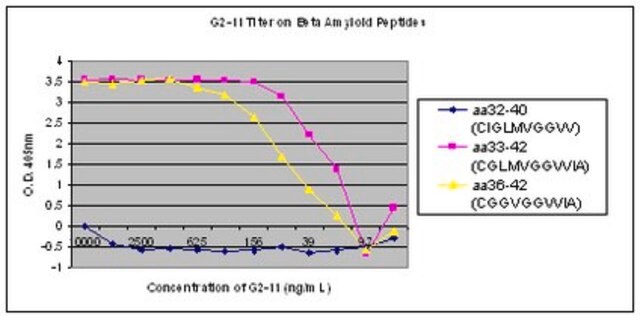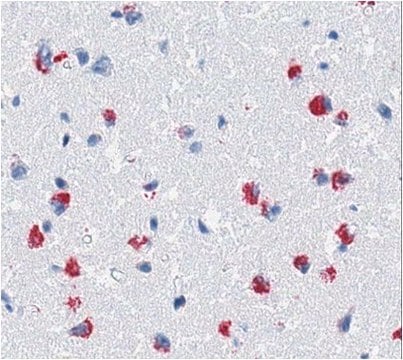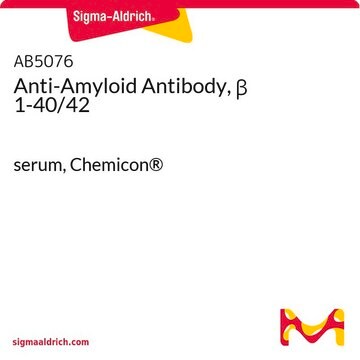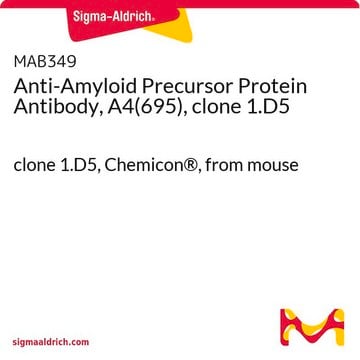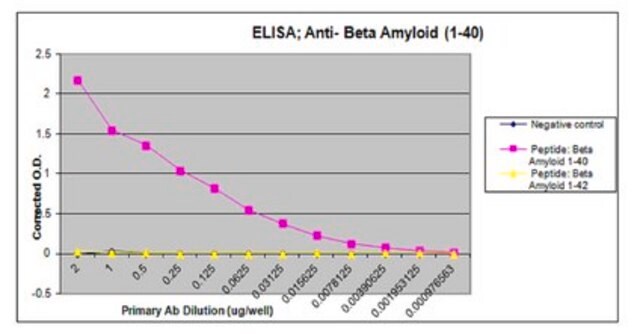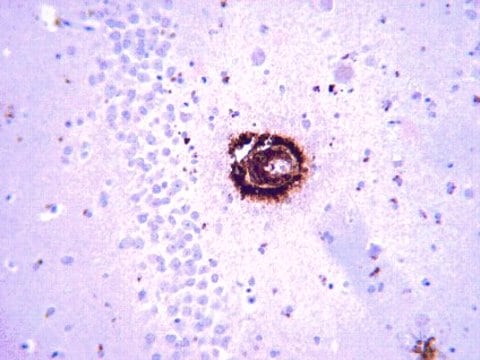MABN254
Anti-amyloid beta peptide (MOAB-2), pan Antibody, clone 6C3
clone 6C3, from mouse
Sinónimos:
Amyloid beta A4 protein, ABPP, APPI, APP, Alzheimer′s disease amyloid protein, cerebral vascular amyloid peptide, CVAP, PreA4, Protease nexin-II, PN-II
About This Item
Productos recomendados
origen biológico
mouse
Nivel de calidad
forma del anticuerpo
purified immunoglobulin
tipo de anticuerpo
primary antibodies
clon
6C3, monoclonal
reactividad de especies
human
técnicas
dot blot: suitable
immunofluorescence: suitable
immunohistochemistry: suitable (paraffin)
immunoprecipitation (IP): suitable
western blot: suitable
Nº de acceso NCBI
Nº de acceso UniProt
Condiciones de envío
wet ice
modificación del objetivo postraduccional
unmodified
Información sobre el gen
human ... APP(351)
Descripción general
Especificidad
Inmunógeno
Aplicación
Western Blot Analysis: A representative lot was used by an independent laboratory in unaggregated forms of Aß42 and Aß40. (Youmans, K.L., et al. (2012). Mol Neurodegener. 7;8.)
Dot Blot Analysis: Serial Aβ40 and Aβ42 dilutions were probed with MOAB-2 or 6E10 by an independent laboratory. (Youmans, K.L., et al. (2012). Mol Neurodegener. 7;8.)
Immunoprecipitationt Analysis: A representative lot was used by an independent laboratory in unaggregated and fibrillar forms of Aß42 and Aß40. (Youmans, K.L., et al. (2012). Mol Neurodegener. 7;8.)
Neuroscience
Neurodegenerative Diseases
Calidad
Immunohistochemistry Analysis: A 1:1,000 dilution of this antibody detected Amyloid Beta Peptide in human Alzheimer′s diseased brain tissue.
Descripción de destino
Forma física
Almacenamiento y estabilidad
Nota de análisis
Alzheimer′s diseased human brain tissue.
Otras notas
Cláusula de descargo de responsabilidad
Not finding the right product?
Try our Herramienta de selección de productos.
Código de clase de almacenamiento
12 - Non Combustible Liquids
Clase de riesgo para el agua (WGK)
WGK 1
Punto de inflamabilidad (°F)
Not applicable
Punto de inflamabilidad (°C)
Not applicable
Certificados de análisis (COA)
Busque Certificados de análisis (COA) introduciendo el número de lote del producto. Los números de lote se encuentran en la etiqueta del producto después de las palabras «Lot» o «Batch»
¿Ya tiene este producto?
Encuentre la documentación para los productos que ha comprado recientemente en la Biblioteca de documentos.
Nuestro equipo de científicos tiene experiencia en todas las áreas de investigación: Ciencias de la vida, Ciencia de los materiales, Síntesis química, Cromatografía, Analítica y muchas otras.
Póngase en contacto con el Servicio técnico
